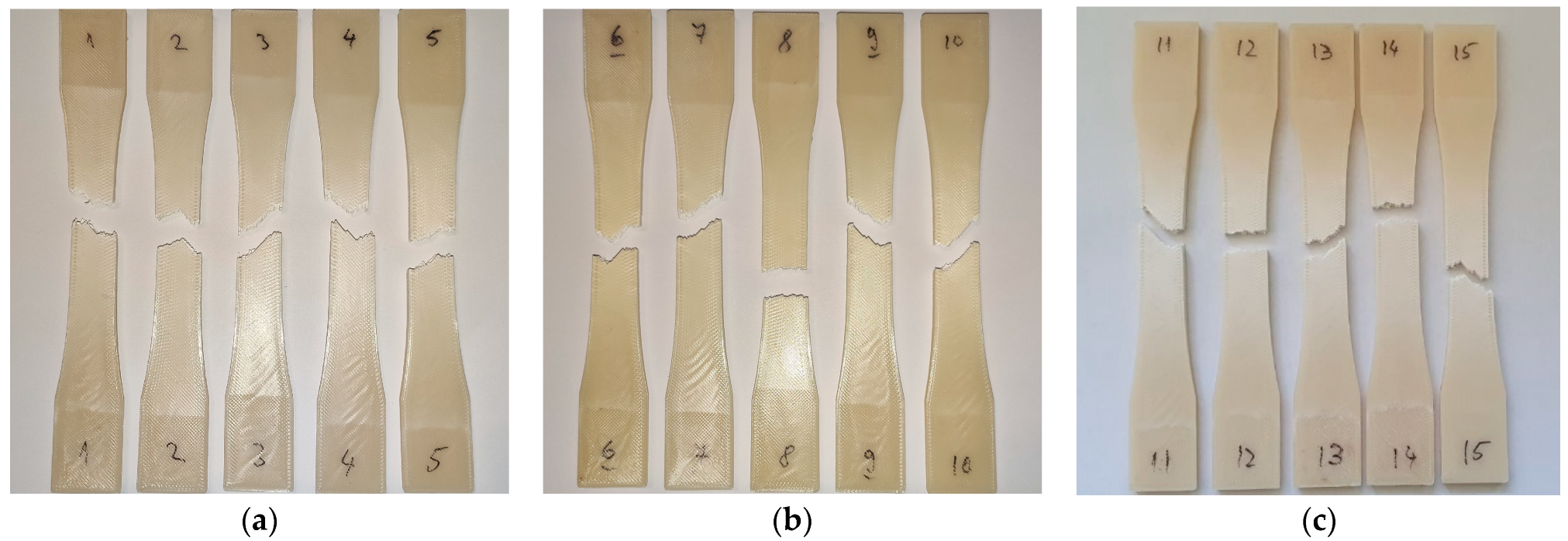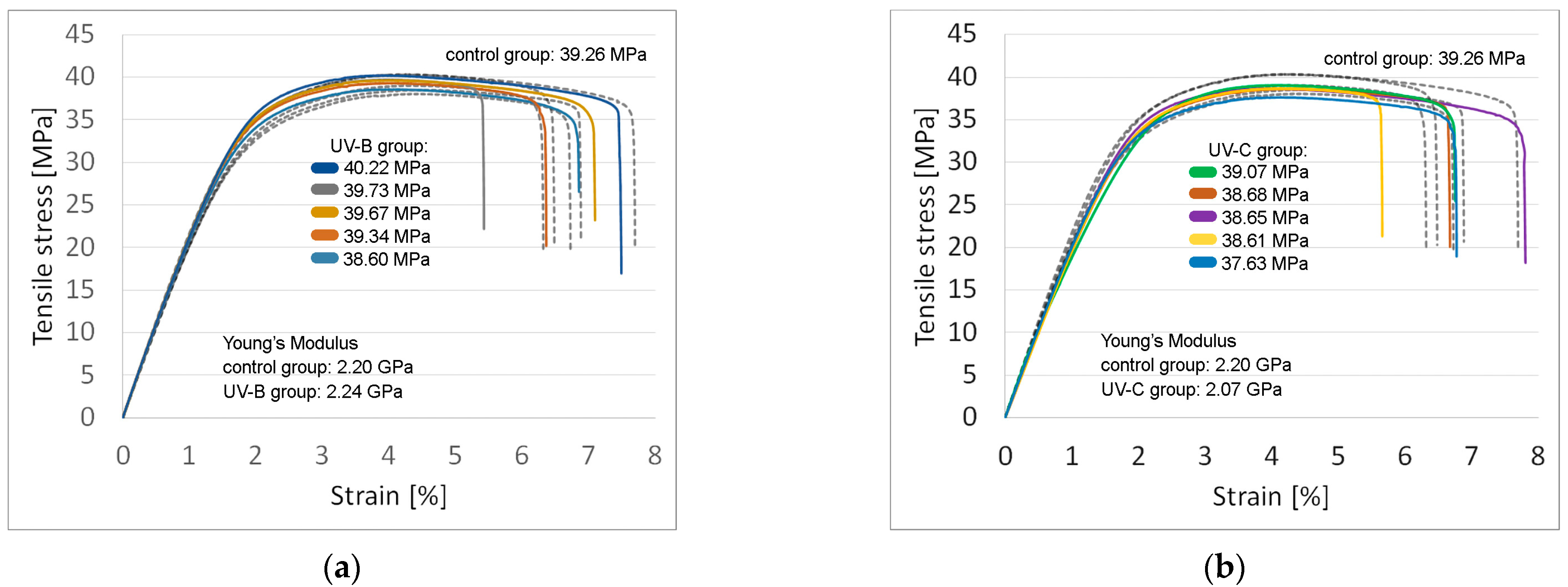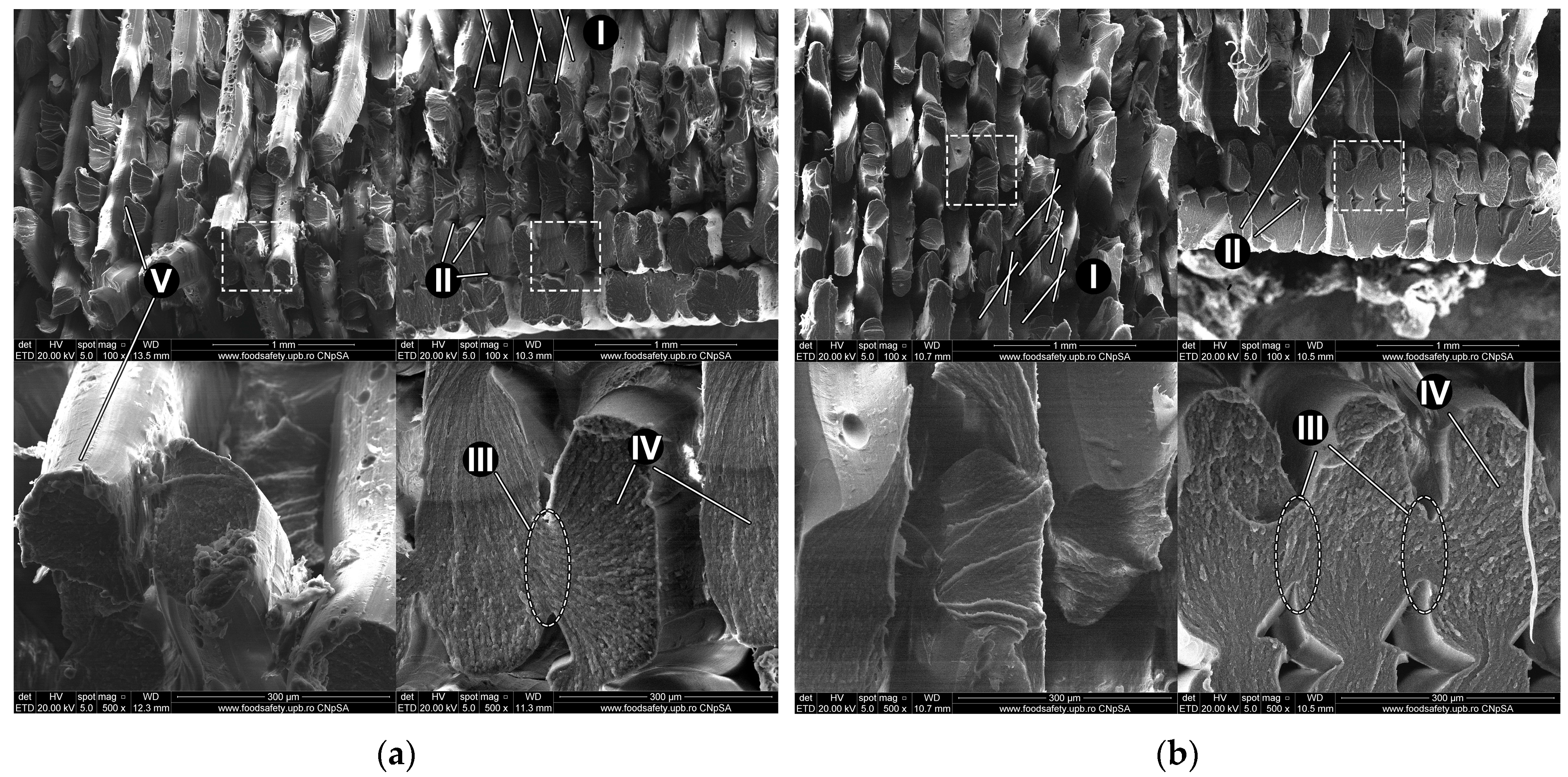Effect of UV-C Radiation on 3D Printed ABS-PC Polymers
Abstract
1. Introduction
2. Materials and Methods
3. Results
3.1. Tensile Strength and Young’s Modulus
3.2. Compressive Strength
3.3. Creep Characteristics of the Analyzed Material
3.4. Scanning Electron Microscopy (SEM)
4. Discussion
5. Conclusions
Author Contributions
Funding
Institutional Review Board Statement
Informed Consent Statement
Data Availability Statement
Conflicts of Interest
References
- World Health Organization. Shortage of Personal Protective Equipment Endangering Health Workers Worldwide. 2020. Available online: https://www.who.int/news/item/03-03-2020-shortage-of-personal-protective-equipment-endangering-health-workers-worldwide. (accessed on 15 March 2023).
- Blanco-Donoso, L.M.; Moreno-Jiménez, J.; Amutio, A.; Gallego-Alberto, L.; Moreno-Jiménez, B.; Garrosa, E. Stressors, job re-sources, fear of contagion, and secondary traumatic stress among nursing home workers in face of the COVID-19: The case of Spain. J. Appl. Gerontol. 2021, 40, 244–256. [Google Scholar] [CrossRef]
- Ranney, M.L.; Griffeth, V.; Jha, A.K. Critical Supply Shortages—The Need for Ventilators and Personal Protective Equipment during the COVID-19 Pandemic. N. Engl. J. Med. 2020, 382, e41. [Google Scholar] [CrossRef] [PubMed]
- Webber, L.; Jewett, C. Testing Swabs Run in Short Supply as Makers Try to Speed up Production. Available online: https://www.npr.org/sections/health-shots/2020/03/18/817801222/testing-swabs-run-in-short-supply-as-makers-try-to-speed-up-production (accessed on 18 March 2023).
- Hufford, A. 3M CEO on N95 Masks: ‘Demand Exceeds Our Production Capacity’. 2020. Available online: https://www.wsj.com/articles/3m-ceo-on-n95-masks-demand-exceeds-our-production-capacity-11585842928 (accessed on 20 March 2023).
- Chen, P.G.; Chan, E.W.; Qureshi, N.; Shelton, S.; Mulcahy, A.W. RAND Health Care–Project Report. Medical Device Supply Chains An Overview and Description of Challenges During the COVID-19 Pandemic. 2021. Available online: https://aspe.hhs.gov/sites/default/files/documents/e48047020834c0c34cf6baf08a9428d0/PR-A328-2-medicaldevices.pdf (accessed on 20 March 2023).
- Park, C.-Y.; Kim, K.; Roth, S.; Beck, S.; Kang, J.W.; Tayag, M.C.; Griffin, M. Global Shortage of Personal Protective Equipment amid COVID-19: Supply Chains, Bottlenecks, and Policy Implications. ADB Briefs 2020, 130. [Google Scholar] [CrossRef]
- Bown, C.P. How COVID-19 Medical Supply Shortages Led to Extraordinary Trade and Industrial Policy. Asian Econ. Policy Rev. 2022, 17, 114–135. [Google Scholar] [CrossRef]
- Ibn-Mohammed, T.; Mustapha, K.B.; Godsell, J.; Adamu, Z.; Babatunde, K.A.; Akintade, D.D.; Acquaye, A.; Fujii, H.; Ndiaye, M.M.; Yamoah, F.A.; et al. A critical analysis of the impacts of COVID-19 on the global economy and ecosystems and opportunities for circular economy strategies. Resour. Conserv. Recycl. 2021, 164, 105169. [Google Scholar] [CrossRef] [PubMed]
- Cohen, J.; Rodgers, Y. Contributing factors to personal protective equipment shortages during the COVID-19 pandemic. Prev. Med. 2020, 141, 106263. [Google Scholar] [CrossRef] [PubMed]
- Jordan, J.M. Additive manufacturing (“3D printing”) and the future of organizational design: Some early notes from the field. J. Org. Des. 2019, 8, 5. [Google Scholar] [CrossRef]
- Mueller, T.; Elkaseer, A.; Charles, A.; Fauth, J.; Rabsch, D.; Scholz, A.; Marquardt, C.; Nau, K.; Scholz, S.G. Eight Weeks Later—The Unprecedented Rise of 3D Printing during the COVID-19 Pandemic—A Case Study, Lessons Learned, and Implications on the Future of Global Decentralized Manufacturing. Appl. Sci. 2020, 10, 4135. [Google Scholar] [CrossRef]
- Ben-Ner, A.; Siemsen, E. Decentralization and Localization of Production: The Organizational and Economic Consequences of Additive Manufacturing (3D Printing). Calif. Manag. Rev. 2017, 59, 000812561769528. [Google Scholar] [CrossRef]
- Malik, A.; Ul Haq, M.I.; Raina, A.; Gupta, K. 3D printing towards implementing Industry 4.0: Sustainability aspects, barriers and challenges. Ind. Rob. 2022, 49, 491–511. [Google Scholar] [CrossRef]
- Choong, Y.Y.C.; Tan, H.W.; Patel, D.C.; Choong, W.T.N.; Chen, C.-H.; Low, H.Y.; Tan, M.J.; Patel, C.D.; Chua, C.K. The global rise of 3D printing during the COVID-19 pandemic. Nat. Rev. Mater. 2020, 5, 637–639. [Google Scholar] [CrossRef]
- Maracaja, L.; Blitz, D.; Maracaja, D.; Walker, C. How 3D Printing Can Prevent Spread of COVID-19 Among Healthcare Professionals During Times of Critical Shortage of Protective Personal Equipment. J. Cardiothorac. Vasc. Anesth. 2020, 34, 2847–2849. [Google Scholar] [CrossRef]
- Manero, A.; Smith, P.; Koontz, A.; Dombrowski, M.; Sparkman, J.; Courbin, D.; Chi, A. Leveraging 3D Printing Capacity in Times of Crisis: Recommendations for COVID-19 Distributed Manufacturing for Medical Equipment Rapid Response. Int. J. Environ. Res. Public Health 2020, 17, 4634. [Google Scholar] [CrossRef] [PubMed]
- Hagen, A.; Chisling, M.; House, K.; Katz, T.; Abelseth, L.; Fraser, I.; Bradley, S.; Kirsch, R.; Morris, J.; Giles, J.W.; et al. 3D Printing for Medical Applications: Current State of the Art and Perspectives during the COVID-19 Crisis. Surgeries 2021, 2, 244–259. [Google Scholar] [CrossRef]
- Longhitano, G.A.; Nunes, G.B.; Candido, G.; da Silva, J.V.L. The role of 3D printing during COVID-19 pandemic: A review. Prog. Addit. Manuf. 2021, 6, 19–37. [Google Scholar] [CrossRef]
- Radfar, P.; Bazaz, S.R.; Mirakhorli, F.; Warkiani, M.E. The role of 3D printing in the fight against COVID-19 outbreak. J. 3D Print. Med. 2021, 5, 51–60. [Google Scholar] [CrossRef]
- Ford, J.; Goldstein, T.; Trahan, S.; Neuwirth, A.; Tatoris, K.; Decker, S. A 3D-printed nasopharyngeal swab for COVID-19 diagnostic testing. 3D Print. Med. 2020, 6, 21. [Google Scholar] [CrossRef]
- Alyouha, S.; Almazeedi, S.; Alghounaim, M.; Al-Mutawa, Y.; Alsabah, S. Polyester tipped 3-dimensionally printed swab that costs less than US$0.05 and can easily and rapidly be mass produced. BMJ Innov. 2020, 6, 262–264. [Google Scholar] [CrossRef]
- Manoj, A.; Bhuyan, M.; Banik, S.R.; Sankard, M.R. 3D printing of nasopharyngeal swabs for COVID-19 diagnose: Past and current trends. Mater. Today Proc. 2021, 44, 1361–1368. [Google Scholar] [CrossRef]
- Wesemann, C.; Pieralli, S.; Fretwurst, T.; Nold, J.; Nelson, K.; Schmelzeisen, R.; Hellwig, E.; Spies, B.C. 3-D Printed Protective Equipment during COVID-19 Pandemic. Materials 2020, 13, 1997. [Google Scholar] [CrossRef]
- Novak, J.I.; Loy, J. A quantitative analysis of 3D printed face shields and masks during COVID-19. Emerald Open Research 2020, 2, 42. [Google Scholar] [CrossRef]
- Wong, K.V.; Hernandez, A. A Review of Additive Manufacturing. Int. Sch. Res. Not. 2012, 2012, 208760. [Google Scholar] [CrossRef]
- Ju, J.; Boisvert, L.N.; Zuo, Y.Y. Face masks against COVID-19: Standards, efficacy, testing and decontamination methods. Adv. Colloid Interface Sci. 2021, 292, 102435. [Google Scholar] [CrossRef]
- O’Kelly, E.; Arora, A.; Pirog, S.; Ward, J.; Clarkson, P.J. Comparing the fit of N95, KN95, surgical, and cloth face masks and assessing the accuracy of fit checking. PLoS ONE 2021, 16, e0245688. [Google Scholar] [CrossRef]
- Dugdale, C.M.; Walensky, R.P. Filtration Efficiency, Effectiveness, and Availability of N95 Face Masks for COVID-19 Prevention. JAMA Intern. Med. 2020, 180, 1612–1613. [Google Scholar] [CrossRef]
- Ballard, D.H.; Jammalamadaka, U.; Meacham, K.W.; Hoegger, M.J.; Burke, B.A.; Morris, J.A.; Scott, A.R.; O’Connor, Z.; Gan, C.; Hu, J.; et al. Quantitative Fit Tested N95 Respirator-Alternatives Generated with CT Imaging and 3D Printing: A Response to Potential Shortages During the COVID-19 Pandemic. Acad. Radiol. 2021, 28, 158–165. [Google Scholar] [CrossRef] [PubMed]
- McAvoy, M.; Bui, A.T.N.; Hansen, C.; Plana, D.; Said, J.T.; Yu, Z.; Yang, H.; Freake, J.; Van, C.; Krikorian, D.; et al. 3D Printed frames to enable reuse and improve the fit of N95 and KN95 respirators. BMC Biomed. Eng. 2021, 3, 10. [Google Scholar] [CrossRef] [PubMed]
- Tipnis, N.P.; Burgess, D.J. Sterilization of implantable polymer-based medical devices: A review. Int. J. Pharm. 2018, 544, 455–460. [Google Scholar] [CrossRef] [PubMed]
- Ghobeira, R.; Philips, C.; Declercq, H.; Cools, P.; De Geyter, N.; Cornelissen, R.; Morent, R. Effects of different sterilization methods on the physico-chemical and bioresponsive properties of plasma-treated polycaprolactone films. Biomed. Mater. 2017, 12, 015017. [Google Scholar] [CrossRef] [PubMed]
- Holmes, S. An overview of current surgical instrument and other medical device decontamination practices. In Woodhead Publishing Series in Biomaterials, Decontamination in Hospitals and Healthcare, 2nd ed.; Walker, J., Ed.; Woodhead Publishing: Sawston, UK, 2020; pp. 443–482. [Google Scholar] [CrossRef]
- Sadeque, M.; Balachandran, S.K. Overview of medical device processing. In Trends in Development of Medical Devices; Shanmugam, P.S.T., Chokkalingam, L., Bakthavachalam, P., Eds.; Academic Press: Cambridge, MA, USA, 2020; pp. 177–188. [Google Scholar] [CrossRef]
- McEvoy, B.; Rowan, N. Terminal sterilization of medical devices using vaporized hydrogen peroxide: A review of current methods and emerging opportunities. J. Appl. Microbiol. 2019, 127, 1403–1420. [Google Scholar] [CrossRef] [PubMed]
- Popescu, D.; Baciu, F.; Vlasceanu, D.; Cotrut, M.C.; Marinescu, R. Effects of multiple sterilizations and natural aging on the mechanical behavior of 3D-printed ABS. Mech. Mater. 2020, 148, 103423. [Google Scholar] [CrossRef]
- Grzelak, K.; Łaszcz, J.; Polkowski, J.; Mastalski, P.; Kluczyński, J.; Łuszczek, J.; Torzewski, J.; Szachogłuchowicz, I.; Szymaniuk, R. Additive Manufacturing of Plastics Used for Protection against COVID19—The Influence of Chemical Disinfection by Alcohol on the Properties of ABS and PETG Polymers. Materials 2021, 14, 4823. [Google Scholar] [CrossRef] [PubMed]
- Popescu, D.; Baciu, F.; Amza, C.G.; Cotrut, C.M.; Marinescu, R. The Effect of Disinfectants Absorption and Medical Decontamination on the Mechanical Performance of 3D-Printed ABS Parts. Polymers 2021, 13, 4249. [Google Scholar] [CrossRef] [PubMed]
- Lindsley, W.G.; Martin, S.B., Jr.; Thewlis, R.E.; Sarkisian, K.; Nwoko, J.O.; Mead, K.R.; Noti, J.D. Effects of Ultraviolet Germicidal Irradiation (UVG) on N95 Respirator Filtration Performance and Structural Integrity. J. Occup. Environ. Hyg. 2015, 12, 509–517. [Google Scholar] [CrossRef]
- van Doremalen, N.; Bushmaker, T.; Morris, D.H. Letter to the Editor: Aerosol and Surface Stability of HCoV-19 (SARS-CoV-2) Compared to SARS-CoV-1. N. Engl. J. Med. 2020, 382, 1564–1567. [Google Scholar] [CrossRef]
- Stojalowski, P.S.; Fairfoull, J. Comparison of Reflective Properties of Materials Exposed to Ultraviolet-C Radiation. J. Res. Natl. Inst. Stand. Technol. 2021, 126, 126017. [Google Scholar] [CrossRef]
- Spicer, D.B. Methods and Mechanisms of Photonic Disinfection. J. Res. Natl. Inst. Stand. Technol. 2021, 126, 126016. [Google Scholar] [CrossRef]
- Standard ISO 4892-3:2016; Plastics–Methods of Exposure to Laboratory Light Sources–Part 3: Fluorescent UV Lamps. Available online: https://www.iso.org/standard/67793.html (accessed on 25 March 2023).
- The National Institute of Standards and Technology. Summary of Event and Post-Workshop Activities. 2020. Available online: https://www.nist.gov/news-events/events/2020/01/workshop-ultraviolet-disinfection-technologies-healthcare-associated-4 (accessed on 25 March 2023).
- IUVA Fact Sheet on UV Disinfection for COVID-19. Available online: https://www.iuva.org/IUVA-Fact-Sheet-on-UV-Disinfection-for-COVID-19 (accessed on 25 March 2023).
- Ngo, T.D.; Kashani, A.; Imbalanzo, G.; Nguyen, K.; Hui, D. Additive manufacturing (3D printing): A review of materials, methods, applications and challenges. Comp. Part B Eng. 2018, 143, 172–196. [Google Scholar] [CrossRef]
- Cantrell, J.; Rohde, S.; Damiani, D.; Gurnani, R.; DiSandro, L.; Anton, J.; Young, A.; Jerez, A.; Steinbach, D.; Kroese, C.; et al. Experimental Characterization of the Mechanical Properties of 3D-Printed ABS and Polycarbonate Parts. In Advancement of Optical Methods in Experimental Mechanics; Yoshida, S., Lamberti, L., Sciammarella, C., Eds.; Conference Proceedings of the Society for Experimental Mechanics Series; Springer: Cham, Switzerland, 2016; Volume 3. [Google Scholar] [CrossRef]
- Arivazhagan, A.; Masood, S.H. Dynamic mechanical properties of ABS material processed by fused deposition modelling. Int. J. Eng. Res. Appl. (IJERA) 2012, 2, 2009–2014. [Google Scholar]
- Pérez, J.; Vilas, J.; Laza, J.; Arnaiz, S.; Mijangos, F.; Bilbao, E.; León, L. Effect of Reprocessing and Accelerated Weathering on ABS Properties. J. Environ. Polym. Degrad. 2010, 18, 71–78. [Google Scholar] [CrossRef]
- Li, J.; Chen, F.; Yang, L.; Jiang, L.; Dan, Y. FTIR analysis on aging characteristics of ABS/PC blend under UV-irradiation in air. Spectrochim. Acta A Mol. Biomol. Spectrosc. 2017, 184, 361–367. [Google Scholar] [CrossRef]
- Greco, R.; Astarita, M.F.; Dong, L.; Sorrentino, A. Polycarbonate/ABS blends: Processability, thermal properties, and mechanical and impact behavior. Adv. Polym. Technol. 1994, 13, 259–274. [Google Scholar] [CrossRef]
- Suarez, H.; Barlow, W.; Paul, D.R. Mechanical properties of ABS/PC blends. J. Appl. Polym. Sci. 1984, 29, 3253–3259. [Google Scholar] [CrossRef]
- Krache, R.; Debbah, I. Some Mechanical and Thermal Properties of PC/ABS Blends. Mater. Sci. Appl. 2011, 2, 404–410. [Google Scholar] [CrossRef]
- Wildes, G.; Keskkula, H.; Paul, D.R. Fracture characterization of PC/ABS blends: Effect of reactive compatibilization, ABS type and rubber concentration. Polymer 1999, 40, 7089–7107. [Google Scholar] [CrossRef]
- Zortrax Product Page–Z-PCABS. Available online: https://zortrax.com/filaments/z-pcabs/ (accessed on 25 March 2023).
- U.S. Food & Drug Administration–Discussion Paper: 3D Printing Medical Devices at the Point of Care. 2021. Available online: https://www.fda.gov/medical-devices/3d-printing-medical-devices/3d-printing-medical-devices-point-care-discussion-paper (accessed on 13 April 2023).
- The Pew Charitable Trusts–Issue Brief: FDA’s Regulatory Framework for 3D Printing of Medical Devices at the Point of Care Needs More Clarity. 2022. Available online: https://www.pewtrusts.org/en/research-and-analysis/issue-briefs/2022/07/fdas-regulatory-framework-for-3d-printing-of-medical-devices-needs-more-clarity (accessed on 13 April 2023).
- Standard ISO 4892-2:2013; Plastics—Methods of Exposure to Laboratory Light Sources—Part 2: Xenon-Arc Lamps. Available online: https://www.iso.org/standard/55481.html (accessed on 20 April 2023).
- Standard BIFMA HCF 8.1-2014; Health Care Furniture Design–Guidelines for Cleanability. Business and Institutional Furniture Manufacturers Association: Grand Rapids, MI, USA, 2014.
- Standard ISO 527-2; Plastics—Determination of Tensile Properties—Part 2: Test Conditions for Moulding and Extrusion Plastics. Available online: https://www.iso.org/standard/4593.html (accessed on 20 April 2023).
- Samykano, M.; Selvamani, S.K.; Kadirgama, K.; Ngui, W.K.; Kanagaraj, G.; Sudhakar, K. Mechanical property of FDM printed ABS: Influence of printing parameters. Int. J. Adv. Manuf. Technol. 2019, 12, 2779–2796. [Google Scholar] [CrossRef]
- Vicente, C.M.; Martins, T.S.; Leite, M.; Ribeiro, A.; Reis, L. Influence of fused deposition modeling parameters on the mechanical properties of ABS parts. Polym. Adv. Technol. 2020, 31, 501–507. [Google Scholar] [CrossRef]
- Giannatsis, J.; Sofos, K.; Canellidis, V.; Karalekas, D.; Dedoussis, V. Investigating the influence of build parameters on the mechanical properties of FDM parts. In Innovative Developments in Virtual and Physical Prototyping, Proceedings of the 5th International Conference on Advanced Research and Rapid Prototyping, Leiria, Portugal, 28 September—1 October 2011; Taylor & Francis: Abingdon, UK, 2012; pp. 525–529. [Google Scholar]
- Tymrak, B.M.; Kreiger, M.; Pearce, J.M. Mechanical properties of components fabricated with open-source 3-D printers under realistic environmental conditions. Mater. Des. 2014, 58, 242–246. [Google Scholar] [CrossRef]
- Galeja, M.; Hejna, A.; Kosmela, P.; Kulawik, A. Static and Dynamic Mechanical Properties of 3D Printed ABS as a Function of Raster Angle. Materials 2020, 13, 297. [Google Scholar] [CrossRef] [PubMed]
- Górski, F.; Wichniarek, R.; Kuczko, W.; Zawadzki, P.; Buń, P. Strength of ABS parts produced by Fused Deposition Modelling technology–a critical orientation problem. Adv. Sci. Technol. 2015, 9, 12–19. [Google Scholar] [CrossRef]
- Opsytec Dr. Grobel. Product Datasheet-Irradiation Chamber BS-02. Available online: https://www.opsytec.com/fileadmin/user_upload/products/downloads/e_bs02.pdf. (accessed on 11 April 2023).
- Standard ISO 4892-1:2016; Plastics—Methods of Exposure to Laboratory Light Sources—Part 1: General Guidance. Available online: https://www.iso.org/standard/60048.html (accessed on 20 March 2023).
- Standard ISO 4582:2017; Plastics—Determination of Changes in Colour and Variations in Properties after Exposure to Glass-Filtered Solar Radiation, Natural Weathering or Laboratory Radiation Sources. Available online: https://www.iso.org/standard/67791.html (accessed on 20 March 2023).
- Standard ASTM D638–22; Standard Test Method for Tensile Properties of Plastics. Available online: https://www.astm.org/Standards/D638 (accessed on 25 March 2023).
- Hassan, A.; Jwu, W.Y. Mechanical properties of high impact ABS/PC blends–effect of blend ratio. In Proceedings of the Polymer Symposium, Kebangsaan Ke-V, Selangor, Malaysia, 23–24 August 2005; pp. 65–76. [Google Scholar]
- Bano, S.; Iqbal, T.; Ramzan, N.; Farooq, U. Study of Surface Mechanical Characteristics of ABS/PC Blends Using Nanoindentation. Processes 2021, 9, 637. [Google Scholar] [CrossRef]
- Standard ASTM D2990–17; Standard Test Methods for Tensile, Compressive, and Flexural Creep and Creep-Rupture of Plastics. Available online: https://www.astm.org/Standards/D2990.htm (accessed on 18 March 2023).
- Zohdi, N.; Yang, R. Material Anisotropy in Additively Manufactured Polymers and Polymer Composites: A Review. Polymers 2021, 13, 3368. [Google Scholar] [CrossRef]
- Zou, R.; Xia, Y.; Liu, S.; Ping Hu, P.; Hou, W.; Hu, Q.; Shan, C. Isotropic and anisotropic elasticity and yielding of 3D printed material. Compos. B Eng. 2016, 99, 506–513. [Google Scholar] [CrossRef]
- Gordelier, T.J.; Thies, P.R.; Turner, L.; Johanning, L. Optimising the FDM additive manufacturing process to achieve maximum tensile strength: A state-of-the-art review. Rapid Prototyp. J. 2019, 25, 953–971. [Google Scholar] [CrossRef]
- Rajpurohit, S.R.; Dave, H.K. Effect of process parameters on tensile strength of FDM printed PLA parts. Rapid Prototyp. J. 2018, 24, 1317–1324. [Google Scholar] [CrossRef]
- Zhang, J.; Yang, B.; Fu, F.; You, F.; Dong, X.; Dai, M. Resistivity and its anisotropy characterization of 3D-printed acrylonitrile butadiene styrene copolymer (ABS)/carbon black (CB) composites. Appl. Sci. 2017, 7, 20. [Google Scholar] [CrossRef]
- Wickramasinghe, S.; Do, T.; Tran, P. FDM-Based 3D Printing of Polymer and Associated Composite: A Review on Mechanical Properties, Defects and Treatments. Polymers 2020, 12, 1529. [Google Scholar] [CrossRef]
- Dawoud, M.; Taha, I.; Ebeid, S.J. Mechanical behaviour of ABS: An experimental study using FDM and injection moulding techniques. J. Manuf. Process. 2016, 21, 39–45. [Google Scholar] [CrossRef]
- Iannuzzi, G.; Mattsson, B.; Rigdahl, M. Color changes due to thermal ageing and artificial weathering of pigmented and textured ABS. Polym Eng Sci 2013, 53, 1687–1695. [Google Scholar] [CrossRef]
- Laureto, J.; Pearce, J. Anisotropic mechanical property variance between ASTM D638-14 type I and type IV fused filament fabricated specimens. Polym. Test. 2018, 68, 294–301. [Google Scholar] [CrossRef]
- Mohamed, O.A.; Masood, S.H.; Bhowmik, J. Creep Deformation Behaviour of PC-ABS Parts Processed by Fused Deposition Additive Manufacturing under Different Extrusion Parameters. In Proceedings of the Society of Plastics Engineers Conference, SPE ANTECA, Anaheim, CA, USA, 8–10 May 2017; pp. 13–16. [Google Scholar]
- Zhang, H.; Cai, L.; Golub, M.; Zhang, Y.; Yang, X.; Schlarman, K.; Zhang, J. Tensile, Creep, and Fatigue Behaviors of 3D-Printed Acrylonitrile Butadiene Styrene. J. Materi. Eng. Perform. 2018, 27, 57–62. [Google Scholar] [CrossRef]
- Rivaton, A. Recent advances in bisphenol-A polycarbonate photodegradation. Polym. Degrad. Stab. 1995, 49, 163–179. [Google Scholar] [CrossRef]
- Torikai, A.; Mitsuoka, T.; Fueki, K. Wavelength sensitivity of the photoinduced reaction in polycarbonate. J. Polym. Sci. Part A Polym. Chem. 1993, 31, 2785–2788. [Google Scholar] [CrossRef]
- Blakey, I.; Yu, A.; Blinco, J.; Jack, K.S.; Liu, H.; Leeson, M.; Yueh, W.; Younkin, T.; Whittaker, A.K. Polycarbonate Based Nonchemically Amplified Photoresists for Extreme Ultraviolet Lithography. Extrem. Ultrav. (EUV) Lithogr. 2010, 7636, 952–959. [Google Scholar] [CrossRef]
- Ramani, R.; Ranganathaiah, C. Degradation of acrylonitrile-butadiene-styrene and polycarbonate by UV irradiation. Polym. Degrad. Stab. 2000, 69, 347–354. [Google Scholar] [CrossRef]
- Yousif, E.; Haddad, A. Photodegradation and photostabilization of polymers, especially polystyrene: Review. Springerplus 2013, 2, 398. [Google Scholar] [CrossRef]
- Malayeri, A.H.; Mohseni, M.; Cairns, B.; Bolton, J.; Chevrefils, G.; Caron, E. Fluence (UV Dose) Required to Achieve Incremental Log Inactivation of Bacteria, Protozoa, Viruses and Algae, IUVA News. Available online: https://iuva.org/resources/Resource%20Documents/Malayeri-Fluence%20Required%20to%20Achieve%20Incremental%20Log%20Inactivation%20of%20Bacteria,%20Protozoa,%20Viruses%20and%20Algae.pdf (accessed on 25 March 2023).
- Ledrise Led Professional. Achieving Effective Germicidal Action with UVC Radiation: A Comprehensive Guide. 2021. Available online: https://www.ledrise.eu/blog/uv-fluence-for-disinfection/ (accessed on 25 March 2023).
- Marek, A.; Verney, V.; Totaro, G.; Sisti, L.; Celli, A.; Bozzi Cionci, N.; Di Gioia, D.; Massacrier, L.; Leroux, F. Organo-modified LDH fillers endowing multi-functionality to bio-based poly(butylene succinate): An extended study from the laboratory to possible market. Appl. Clay Sci. 2020, 188, 105502. [Google Scholar] [CrossRef]
- Rajan, V.; Waber, R.; Wieser, J. Influence of different types of UV absorber/UV stabilizer combination on the photodegradation of PC/ABS blend. J. Appl. Polym. Sci. 2011, 124, 4007–4015. [Google Scholar] [CrossRef]
- Popescu, D.; Zapciu, A.; Amza, C.G.; Baciu, F.; Marinescu, R. FDM process parameters influence over the mechanical properties of polymer specimens: A review. Polym. Test. 2018, 69, 157–166. [Google Scholar] [CrossRef]








| Material | Layer Height | Perimeters | Infill | Infill Pattern | Extrusion Temperature | Bed Temperature |
|---|---|---|---|---|---|---|
| Z-PCABS | 0.19 mm | 2 | 100% | “Grid” 45°/−45° | 265 °C | 85 °C |
| Tensile Strength Sample | Compression Strength Sample | |||
|---|---|---|---|---|
| Width | Height | X | Z | |
| 3D model [mm] | 13.00 | 4.20 | 15.00 | 15.00 |
| Control samples [mm] | 13.07 ± 0.012 | 4.15 ± 0.016 | 15.00 ± 0.016 | 15.16 ± 0.010 |
| UV-C samples [mm] | 13.09 ± 0.010 | 4.14 ± 0.010 | 15.01 ± 0.010 | 15.18 ± 0.012 |
| Property | ABS-PC (no UV) | ABS-PC (UV-B) | ABS-PC (UV-C) |
|---|---|---|---|
| Tensile strength [MPa] | 39.26 ± 0.47 | 39.51 ± 0.27 | 38.53 ± 0.24 |
| Young’s Modulus [MPa] | 2196.4 ± 31.7 | 2238.1 ± 9.78 | 2074.9 ± 39.8 |
| Property | ABS-PC (no UV) | ABS-PC (UV-B) | ABS-PC (UV-C) |
|---|---|---|---|
| Compressive str. [MPa] | 61.81 ± 0.41 | 58.60 ± 0.37 | 57.82 ± 0.52 |
| Material | Test Parameter | |||
|---|---|---|---|---|
| Strength [MPa] | Creep Test Stress [MPa] | Targeted Tensile Force on Sample [N] | Test Rig Load Configuration | |
| ABS-PC | 39.26 | 9.82 | 154 | 22 N × 7 |
Disclaimer/Publisher’s Note: The statements, opinions and data contained in all publications are solely those of the individual author(s) and contributor(s) and not of MDPI and/or the editor(s). MDPI and/or the editor(s) disclaim responsibility for any injury to people or property resulting from any ideas, methods, instructions or products referred to in the content. |
© 2023 by the authors. Licensee MDPI, Basel, Switzerland. This article is an open access article distributed under the terms and conditions of the Creative Commons Attribution (CC BY) license (https://creativecommons.org/licenses/by/4.0/).
Share and Cite
Amza, C.G.; Zapciu, A.; Baciu, F.; Radu, C. Effect of UV-C Radiation on 3D Printed ABS-PC Polymers. Polymers 2023, 15, 1966. https://doi.org/10.3390/polym15081966
Amza CG, Zapciu A, Baciu F, Radu C. Effect of UV-C Radiation on 3D Printed ABS-PC Polymers. Polymers. 2023; 15(8):1966. https://doi.org/10.3390/polym15081966
Chicago/Turabian StyleAmza, Catalin Gheorghe, Aurelian Zapciu, Florin Baciu, and Constantin Radu. 2023. "Effect of UV-C Radiation on 3D Printed ABS-PC Polymers" Polymers 15, no. 8: 1966. https://doi.org/10.3390/polym15081966
APA StyleAmza, C. G., Zapciu, A., Baciu, F., & Radu, C. (2023). Effect of UV-C Radiation on 3D Printed ABS-PC Polymers. Polymers, 15(8), 1966. https://doi.org/10.3390/polym15081966







